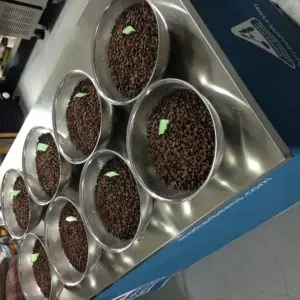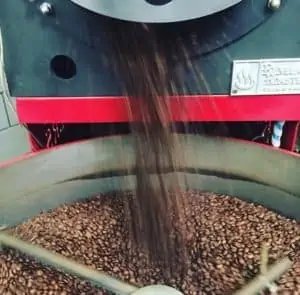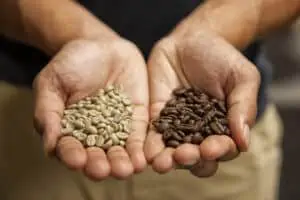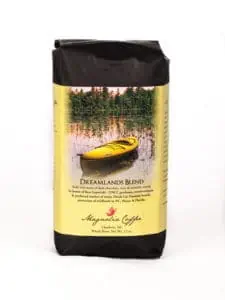Those readers sensitive to language and to shifting, overlapping tastes in the coffee world may have noticed the nuance in the title of this report: “darker–roasted” coffees rather than “dark-roasted.” When titling this report we wanted to avoid encouraging a polarization between those coffee drinkers who prefer at least a little (perhaps a lot) of the bittersweet pungency promoted by darker roasting and those who are lovers of lighter-roasted (sometimes very light-roasted) coffees with their bright profiles and fruit, floral and cocoa tones. By writing darker rather than dark we hoped to soften that potential polarization.
Which leads to a two-part confession. First confession: Coffee Review, over 20 years of reviewing, has not managed to award a whole lot of high ratings to darker-roasted coffees. Along with the innovating edge of the specialty industry, we have gravitated toward coffees roasted light to medium, a roast style that foregrounds the taste of the bean rather than the taste of the roast—taste of tree variety, taste of processing method, taste of place.
Second confession: We have not been entirely happy about this. A large chunk of American coffee drinkers love darker-roasted coffees. We would like for them to benefit from visiting our site, regardless of their preferences in roast. We want to help them find the very best darker roasted coffees produced today, coffees they will genuinely enjoy without changing their fundamental expectations about how a coffee should taste. This is why, whenever we come across an obviously darker-roasted coffee on the cupping table, we find ourselves pulling for it. But too often, for us at least, the roast seems to get in the way of the coffee. The pungent bittersweetness of the darker roast too often overpowers nuance, leaving us very little to describe aside from the taste of the roast itself, whether that taste is, on the downside, burned and rubbery, or on the upside, pleasingly intense, bracing and pungent— agreeably “bold” in Starbucks-speak. But, in either case, a darker roast often mutes or obscures the individuality that excites us and sets us off scribbling enthusiastic descriptors on our rating sheets.
This lean toward light- to medium-roasted coffees apparently has not escaped the notice of roasting companies that nominate coffees for our monthly tasting reports. Over the years we have received fewer and fewer darker-roasted samples and more and more light- and medium-roasted submissions. This has led to a regrettable chicken-and-egg effect: Fewer darker-roasted coffees submitted means fewer darker-roasted coffees reviewed means fewer darker roasted coffees submitted, etc.
Taking Back the Dark, Big Time: A Tale of 140 Coffees
Consequently this report: an effort to get darker-roasted coffees back into our review mix.
And, it would appear, roasters noticed this effort, appreciated it, and responded. Really responded.
For most report topics we receive, on average, about 35 samples per report. For this report we received 140 samples. Of that 140, we had to disqualify 10 because they were medium-roasted rather than dark-roasted, as determined by our Agtron roast-color reader. Still, that left 130 darker-roasted coffees submitted by 99 different roasters.
It appears that many of the roasters with whom we later corresponded shared the same feeling that we had: Darker roasts are being taken for granted at the leading edge of the specialty coffee world. Perhaps that is what motivated them to respond so robustly to this month’s call for samples.
None of the roasters with whom we later communicated identified their companies as particularly focused on darker-roasted coffees. In fact, many roast the majority of their coffees medium or lighter. Yet all acknowledge a respect for darker roasts, recognize that many of their customers prefer them to medium roasts, and are determined to do right by both their customers and their coffees by offering excellently presented darker roasts. (See the end of this report for more on roaster attitudes toward darker roasts.)
Managing 130 Samples
At any rate, we did manage to cup, carefully and mindfully, all 130 samples, each one identified only by number. In the case of these darker roasted coffees, we poured the water at a slightly lower temperature than we do for the medium-roast coffees.
In a typical round of cupping, three of us participate. It takes us about 30 minutes or more per sample, first cupping in silence, then discussing the results and settling on a final score and basic descriptors. Before we realized that an avalanche of fine darker-roasted coffees was about to descend on us, we cupped about 20 samples using our usual deliberate approach. But as the next 100+ coffees arrived we had to change our strategy. We started running elimination rounds, in which, after a blind cupping, the three of us each gave a simple thumbs-up or thumbs-down to every coffee on the table. The criterion for a thumbs-up was: We think this coffee has a good chance of scoring 90 or better and making the final cut for reviewing.
We then recupped those coffees that passed the elimination rounds, using our usual more lengthy and deliberate procedure.
Same Criteria, One Small Change
Did we change any of our criteria or expectations for these dark roasts?
We did not. We stuck with our usual expectations. We did, however, make one small but important change in how we structure and communicate our evaluation of a coffee.
Look at a typical review published before this date on Coffee Review, and you will see that the evaluation is based on five attribute categories: Aroma, Acidity, Body, Flavor and Aftertaste.
One of the reasons darker roasts score somewhat lower in traditional cupping systems like the one we use at Coffee Review is because they often don’t perform well in the Acidity category. A capsule description of acidity might read: “tart sweetness nuanced by fruit or floral tones.” It reflects the purity of the coffee fruit itself, which when perfectly ripe combines an almost sugary sweetness with a light, cherryish tartness. It is mainly a taste sensation sensed on the tongue; among the six basic tastes it always combines sweet and tart, along with a little bitter and occasionally a hint of savory or umami.
Coffee insiders tend to be very attached to acidity as a coffee descriptor. It figures prominently on virtually every green coffee cupping sheet I know of, perhaps because it is a sign of quality. Lower-grown Arabica coffees, almost all Robusta coffees, and poorly processed coffees of any species lack a bright, balanced acidity. They may taste flat, or bitter, but not bright or acidy.
Acidity and Darker Roasts
But such privileging of acidity is not helpful in interpreting the appeal of darker-roasted coffees because, generally, darker roasting transforms the acidy sensation. Darker roasting reduces the presence of the pleasingly sweet, apple-like malic acid, while at the same time promoting the breakdown of tasteless chlorogenic acid to bitterish quinic acid. Thus, in darker roasts, very broadly speaking, we taste less sweet malic acid and more bitterish quinic acid. At the same time, by way of partial compensation, moderate dark roasting promotes a caramelly or chocolaty sweetness, hence the bittersweet sensation that so often marks a moderately dark to dark roast, a sensation generally beloved by lovers of darker-roasted coffees.
Broadening the Acidity Category
What we have decided to do in all of our reviews from this month forward is to evaluate the total impact of all relevant basic tastes (sweet, tart, bitter, savory) under the renamed category Acidity/Structure. Note that in this approach the acidity criterion is not lost or bypassed; it is simply evaluated and described in the larger context of all of the basic tastes and their total impact on the balance and pleasingness of the cup. Thus, in a classically brightly sweet wet-processed coffee, we will most likely register and describe Acidity/Structure almost purely in terms of the sweet/tart sensation coffee people call “acidity.” A deeply tart Kenya or a delicately sweet/tart Yirgacheffe will still score high in Acidity/Structure. However, in a moderately darker-roasted coffee, we might register and describe a more general balance of tart, sweet and bitter sensations; in a still-darker cup we might end up only describing the balance of sweetness and bitterness and perhaps some savory contribution. But our overall expectation for the category remains the same in any case: We look for complexity, balance and pleasingness.
A final correction and caution: Under this category, regardless of whether we call it Acidity or Acidity/Structure, we are mainly describing basic tastes: sweet, tart, bitter, savory/umami. Aromatic notes—the floral, nut, chocolate, fruit and aromatic wood notes that figure so prominently in coffee descriptions—we evaluate in relation to two other categories, Aroma (aroma registered directly in the nose) and Flavor (aromas originating in the mouth, but carried to the nose and influenced by the basic tastes).
Returning to this month’s cupping and dark roasts: By broadening the Acidity category to include consideration of all of the basic tastes, we hoped to avoid punishing darker roasts simply because they are not intensely bright or acidy, while at the same time continuing to apply rigorous expectations with regard to the balance and pleasingness of how a coffee embodies the basic tastes. We are able to honor caramelly bittersweetness, for example, or deep, savory-leaning bittersweetness, assuming they are balanced and engaging and effectively support the aromatic superstructure of the cup.
The Darker-Roast Scorecard
So, given all of that, including broadening the Acidity category, how did we do with the 130 darker-roasted coffees?
Rather well, though perhaps not brilliantly. We rated 13 samples (or 10% of the total tested) at 90 points or higher; 12 of those 13 are reviewed here (one roaster submitted two 90+ samples of which we reviewed only one). Keep in mind that some of those samples we dismissed in our elimination round might have scored close to 90 or even had a shot at 90, so we may be under-representing those borderline 90+ coffees in our final statistic.
Signs of Success
What were some of the characteristics shared by these 13 successful 90+ darker-roasted coffees?
They were all quite distinctive, for starters. Most were roasty, it is true, but they escaped the roast-first, pungently bittersweet (often more bitter than sweet) sameness that distinguishes many of the solid but unexceptional dark-roasted coffees that we end up rating somewhere between 86 and 88. On the other hand, they also escaped the clean, moderately bright but aromatically empty sameness that we experience from many medium-roasted coffees that we also typically rate between 86 and 88. I would hazard that this set of 13 darker-roasted coffees probably expressed more individuality overall than displayed by many of the top-rated sets of medium-roasted coffees we have reviewed over the years.
The individuality of these 90+ darker-roasted coffees originated, in part, from the impact of the roast, of widely varied but successfully executed darker-roast profiles. But it also derived from the impact of strong-charactered green coffees.
The Origin Scoreboard
To start with the green coffees: Of the 13 samples we rated 90+, most were single-origin coffees of types known for their individuality. Among 10 single-origin samples we had three Kenyas, three Ethiopias, two Sumatras, and one Colombia from trees of the unique-cupping Gesha variety. The surprise among the single-origins was the 93-rated Peru Cajamarca Organic from Black Coffee Roasting. Peru coffees have greatly improved over recent years, but they remain admired largely for their smooth balance and quiet completeness. Which, as it turns out, were the most striking characteristics of the 93-rated Black Coffee Peru, which we described as “Quiet, complete; complexly chocolate- and fruit-toned.” Jim Chapman of Black Coffee pointed out in an email that, “This coffee has some beautiful and elegant notes as it leans toward the darker spectrum, but it is by no means just the roast level that takes it there. That is this coffee’s natural flavor. [But roasted] too light and it [is] weak and shy. It needs some caramelization of sugars to bring out its fullness and body.”
The Roasts: From the Cusp of Dark to the All-Out Dark
Final roast colors among the 90+ samples ranged from very explicit dark roasts to those hovering just at the cusp between medium and medium dark. The darkest-roasted among the 13 reviewed samples was the 93-rated Mellelo Coffee Roasters’ Ethiopia Organic Dark. The dark roast pretty much dominated the usual bright, delicate floral, cocoa and citrus characteristics of this coffee type, yet they remained, vibrating inside the richly pungent dark-roast character. For us, a coffee like this one is a find: A “real” dark roast delivering the resonant, reverberating punch of the style yet still maintaining smooth mouthfeel, enough sweetness to round and balance bitterness, and above all a continuing engaging range of aroma and flavor notes.
The top-rated Amavida Colombia Gesha (95), on the other hand, sat right at the cusp of medium and medium dark. Although without showing a sign of the pungent bittersweetness of a full-on dark roast like the Mellelo Ethiopia, the roast nevertheless appeared to round and deepen the usual Gesha brightness while allowing the spectacular citrus, cocoa and floral Gesha aromatics to remain vibrantly in front and recognizable, netting a cup that should appeal to those who want the soaring Gesha aromatics without the often assertive Gesha acidity.
A fourth sample filling out the top of the ratings, the 94-rated Kenya from Korean roaster Another Beans, was a something-for-everybody darker roast. On one hand, it offered a very explicit dark-roasted richness, while on the other maintained the individuality of the great Kenya type, including a full complement of lavender and black currant aromatics, plush mouthfeel and zesty tartness.
Roasters’ Dilemma
When we looked at the steady stream of darker roasts emerging from the boxes and padded envelopes in our lab, we wondered about all of these roasters who had sent us coffee, and how they felt about darker roasts. We wondered how they situated themselves in a world of taste where, on one hand, the leading edge of the industry is almost stridently committed to medium- or light-roasting, while, on the other, so many consumers remain attached to their tastes for darker-roasted profiles.
To get some feel for this question, we sent out an Internet survey to which 29 roasters generously responded. In addition, nearly ten of the roasters with coffees we reviewed this month sent more extended comments about darker roasts and their issues.
Darker-Roast Strategies: Openness, Accommodation and Poetry
The basic answer seems to be that most responding roasters are focused mainly on medium- and light-roasting, while at the same time doing their best to keep lovers of darker roasts happy with coffees that still “let the bean dictate the roast,” as Black Coffee’s Jim Chapman puts it.
In the case of the fairly large San Francisco Bay Area roaster Equator Coffee—the source of the twisty, spice- and aromatic-wood-toned Mocha Java Blend reviewed here at 91—the response appears to be keep the blends dark but not too dark, while doing the fancier single-origins lighter. Ted Stachura, Director of Coffee, writes that, “Equator offers a broad range of roast degree. We do not want to be the lightest or darkest coffee roaster; but rather appeal to a range of tastes. We try to develop flavor fully whatever the roast degree; for darker roasted blends that means just dark enough to impart roast-impact in the cup without crushing the flavor/aroma of the component coffees and also to retain sweetness/minimize bitterness.”
Jon Frech of northern California roaster Black Oak Coffee, whose Duomo Northern Italian Style blend is reviewed here at 91, admits that, “We don’t have a norm. Our roast styles, like our customer’s preferences, fall all over the roast spectrum. We try to do the best job we can sourcing and roasting across roast levels from super light to French. … We think of roast as a component of a coffee’s flavor and we want to keep that sweet balance as roast degree increases. We won a few national awards last year for our lighter-roasted Ethiopian coffees, so [for a] national audience, we might be well known for some pretty light roasting styles. However, to our local and regional customers, we are probably known as being a third-wave type roaster that does not eschew darker roasts.”
Jay Gestwicki of North Carolina’s Magnolia Coffee notes that his Dreamlands Blend, reviewed here at 90, “is noticeably darker than the majority of our offerings. We have found that the majority of our market does prefer ‘medium’ style roasts with milder cup characteristics of milk chocolate, nuts and milder fruit tones. However, there is definitely a very loyal following for darker roasted coffees that are not bitter.”
Finally, one of the most poetic tributes to flexibility in roast profile came from the roaster of Kustom Coffee’s classically idiosyncratic and foresty Sumatra Narat Nauli, reviewed here at 90. Arka Chaudhuri writes: “I see darker roasting as a technique to magnifying favorable attributes of beans that lend themselves to exploration. Once in a while, it burns through the coffee’s expected character to reveal new glories underneath. I also believe that it is a test of the roaster’s sense of restraint — the ability to amplify flavors without breaking them down. Dark roasting shouldn’t be a crutch to rest on, nor a wall to hide behind. The bean should still speak, but in more modulated tones than is usually expected. Sometimes the words they say may be harsh and blunt. At other times they may lead us to a deeper wisdom.”
Thanks for the Words and the Coffees
I hope so, and I hope that this report and reviews help ease and clarify the often unspoken polarization between lighter and darker roast styles in today’s specialty coffee world, and along the way helps everyone find the coffees they like. Thanks to all of the nearly 100 roasters who sent us their darker roasts, to the 30 or so who responded to our quick survey, as well to those who later replied so promptly and elegantly to my follow-up questions.















